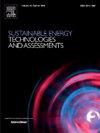Fuel cell technology review: Types, economy, applications, and vehicle-to-grid scheme
IF 7.1
2区 工程技术
Q1 ENERGY & FUELS
Sustainable Energy Technologies and Assessments
Pub Date : 2025-02-10
DOI:10.1016/j.seta.2025.104229
引用次数: 0
Abstract
This study conducts a thorough review of fuel cell technology, including types, economy, applications, and V2G scheme. Fuel cells have been considered for diverse applications, namely, electric vehicles, specialty vehicles such as warehouse forklifts, public transportation including buses, trains, and ferries. Other applications include grid-related, stationary, and portable applications. Among available five types of fuel cells, PEMFC is presently the optimal choice for electric vehicle usage due to its low operating temperature and durability. Meanwhile, high temperature fuel cells such as MCFC and SOFC currently remain the best choice for utility and grid related applications. The economy of fuel cells has been continuously improving and has been illustrated to only grow into a potential main source of sustainable energy soon. With the transportation sector, as fuel cell electric vehicles evolve, V2G technology is beneficial towards energy efficiency and fuel cell economy. There is evidence for V2G using FCEV being more advantageous in comparison to conventional BEVs. The costs of the five types of fuel cell vary from US$1784 to US$4500 per kW capacity. The findings are beneficial for researchers and industry professionals who wish to gain comprehensive understanding of fuel cells for adoption and development of the emerging low-emission energy solutions.
求助全文
约1分钟内获得全文
求助全文
来源期刊

Sustainable Energy Technologies and Assessments
Energy-Renewable Energy, Sustainability and the Environment
CiteScore
12.70
自引率
12.50%
发文量
1091
期刊介绍:
Encouraging a transition to a sustainable energy future is imperative for our world. Technologies that enable this shift in various sectors like transportation, heating, and power systems are of utmost importance. Sustainable Energy Technologies and Assessments welcomes papers focusing on a range of aspects and levels of technological advancements in energy generation and utilization. The aim is to reduce the negative environmental impact associated with energy production and consumption, spanning from laboratory experiments to real-world applications in the commercial sector.
 求助内容:
求助内容: 应助结果提醒方式:
应助结果提醒方式:


